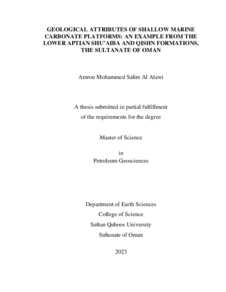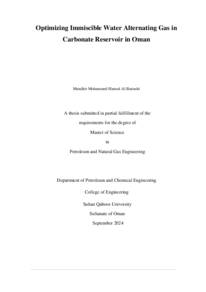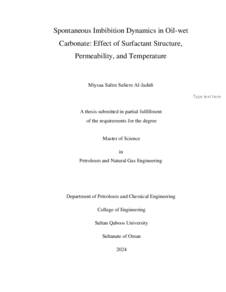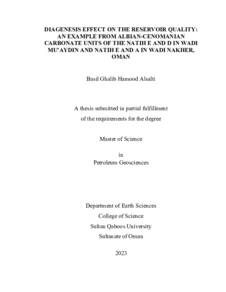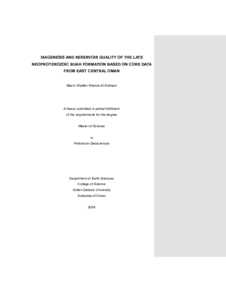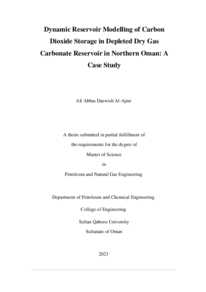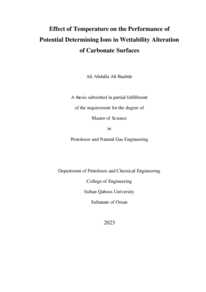Document
Geological attributes of shallow marine carbonate platforms : an example from the Lower Aptian Shu’aiba and Qishn formations, the Sultanate of Oman.
Source
Master's thesis
Other titles
الخصائص الجيولوجية للمنصات الكربونانية البحرية الضحلة : مثال من تكوينات شعيبة وقشن الابتية السفلية، سلطنة عمان
Country
Oman
City
Muscat
Publisher
Sultan Qaboos University
Gregorian
2023
Language
English
Thesis Type
Master's thesis
English abstract
Carbonate reservoirs demand special attention due to their substantial contribution
to global oil and gas reserves. In fact, these reservoirs account for approximately 60% of
the world's remaining oil and gas reserves. Moreover, they naturally exhibit numerous
favorable attributes for carbon dioxide (CO2) storage. As such, the continued exploration
and development of these reservoirs are not just essential for meeting future global energy
demands, but they also play a crucial role in achieving net-zero carbon emissions by
utilizing depleted reservoirs as sinks for CO2 sequestration. The quality of these reservoirs,
particularly their porosity and permeability, is significantly influenced by a variety of
factors including their depositional environment and diagenetic evolution. Thus,
conducting research in these areas offers a unique opportunity to predict reservoir
properties and gain an understanding of their distribution and evolution. The Lower
Aptian Carbonates, namely the Lower Shu’aiba and its equivalent, the Upper Qishn, are
widely recognized in the Arabian Peninsula for their substantial hydrocarbon reserves
presenting an excellent opportunity for studying and evaluating the depositional
environment and the impact of diagenetic modifications, which can further the
understanding of reservoir quality.
Approximately 59 m of the outcropped Lower Shu’aiba in Wadi Bani Kharus and
22 m of the outcropped Upper Qishn in Wadi Baw were studied for facies analysis,
diagenesis, and reservoir quality. A total of 26 selected samples were collected from both
outcrops, all of which were used to prepare thin sections. These were then studied under
a microscope and subjected to point counting (300 points). Of these samples, 12 were
further analyzed using Scanning Electron Microscopy (SEM) and geochemical analyses,
including X-ray Fluorescence (XRF), X-ray Diffraction (XRD), and Energy-Dispersive
X-ray Spectroscopy (EDS). Additionally, 16 samples underwent coring and porosity and
permeability measurements.
In the investigated sites of Wadi Baw in East Central Oman and Wadi Bani Kharus
in North Oman, 17 different microfacies have been identified deposited in a diverse array
of depositional environments namely, lagoon, reef, open marine-algal platform, and open
marine-slope, underscoring a clear gradational transition from proximal to distal settings.
The deeper, distal part of the basin is represented by Wadi Bani Kharus with its distinctive
slope microfacies, while Wadi Baw, with its coarser-grained lithofacies, is indicative of
the proximal, high-energy environment.
Regional variations in diagenetic alterations have been noted, influencing the
reservoir quality of the Lower Aptian Carbonates. Specifically, these variations are
evident when comparing the Lower Shu’aiba of Northern Oman to the Upper Qishn in
Central Oman. The northern region is marked by pronounced fracturing and subsequent
calcite cementation that fills these fractures, while Central Oman shows a strong presence
of dolomitization and dissolution. Notably, the Upper Qishn in Wadi Baw is home to
unique dolomite microfacies. These microfacies present a classification challenge due to
their non-mimetic nature and suggest the presence of dolomitization mechanisms in
Central Oman that aren't found in the north. Such diagenetic changes play a crucial role
in determining the reservoir quality in both areas.
The microfacies, which are indicative of the depositional environment, play a role
in determining reservoir quality. In particular, the presence of interparticle microporosity
and intrafossil porosity, especially within microfacies containing foraminifera,
significantly boosts the overall reservoir quality. While the Lower Aptian Carbonates
display high porosity, their permeability remains low due to limited pore
interconnectivity. In Wadi Baw, these carbonates have higher porosity and permeability
values than in Wadi Bani Kharus, where the porosity is poor, and permeability is nil. This
disparity can be attributed to the different burial depths experienced by these regions;
Wadi Baw underwent shallow burial, whereas Wadi Bani Kharus was subjected to deep
burial during the ophiolite obduction.
The Upper Qishn emerged from preliminary assessments as a promising site for
Carbon dioxide (CO2) storage. Despite slightly below-threshold permeability, the
formation's favorable average porosity, thickness, and depth indicated potential for
efficient supercritical CO2 storage. Geochemical analyses further revealed the formation's
mineralogical suitability for stable, long-term CO2 storage via mineralization.
Arabic abstract
تتطلب الخزانات الكربونانية اهتما ًما خاصا نظرا لمساهمتها الكبيرة في الاحتياطيات العالمية للنفط والغاز. في الواقع، تشكل هذه الخزانات حوالي %60 من الاحتياطيات المتبقية للنفط والغاز في العالم. عالوة على ذلك، تحتوي على العديد من الخصائص المالئمة لتخزين ثاني أكسيد الكربون. وبالتالي، فإن استمرار التنقيب والتطوير عن هذه الخزانات ليس فقط أمًرا أساسيًا لتلبية الطلب العالمي المستقبلي على الطاقة، ولكنها تلعب أي ًضا دو ًرا حاس ًما في تحقيق الحياد الصفري الكربوني من خالل استخدام الخزانات المستنفدة لتخزين غاز ثاني اكسيد الكربون. تتأثر جودة هذه الخزانات بشكل كبير بمجموعة من العوامل بما في ذلك بيئتها الترسيبية و التحورات اللاحقة. وبالتالي، يوفر إجراء البحوث في هذه المجالات فرصة فريدة للتنبؤ بخصائص الخزان و فهم توزيعها وتطورها. تعرف الكربونات الا بتية تكوين الشعيبة السفلى السفلية، وتحديدا وما يعادله، تكوين قشن العلوي على نطاق واسع بسبب مساميتها ونفاذيتها. ً حيث انها تعمل كصخور خزان مهمة في الشرق الاوسط و تقدم فرصة ممتازة لدراسة وتقييم بيئة الترسيب وتأثير التحورات اللاحقة التي يمكن أن تعمق فهم جودة الخزان. في المواقع المدروسة في وادي باو في شرق وسط عمان و وادي بني خروص في شمال عمان، تم تحديد 17 نوع من السحنات الدقيقة التي تنتمي إلى مجموعة متنوعة من بيئات الترسيب في نظام الكربونات الابتية السفلية، مما يبرز انتقا البيئة القريبة الضحلة إلى البعيدة العميقة. يتم تمثيل الجزء العميق، البعيد للحوض ًال تدريجيًا واض ًحا من بوادي بني خروص ، بينما يشير وادي باو، مع تركيباته الحجرية ذات الحبيبات الخشنة، إلى البيئة القريبة ذات الطاقة العالية. فقد تم مالحظة اختالفات إقليمية في، مما أثر على جودة خزان الكربونات الابتية السفلى في تكوين شعيبة بتكوين قشن العلوي في وسط عمان. حيث يتميز الشمال بانتشار أكبر للتشققات ً السفلي شمال عمان مقارنة و تكون الاسمنت الكلسي الذي يمأل هذه التشققات، في حين تكون الدولومتة والذوبان أكثر وضوحا في وسط عمان. تشكل سحنات الدولومي ت الدقيقة المميزة التي تم العثور عليها في تكوين القشن العلوي في وادي باو تحديًا في التصنيف بسبب طبيعتها و تشير إلى وجود آليات دولومتة في شرق وسط عمان غير موجودة في الشمال . تمت دراسة حوالي 59 مترا من تكوين شعيبة السفلى في وادي بني خروص و 22 مت ًرا من تكوين قشن العلوي في وادي باو لتحليل السحنات، التحورات اللاحقة، وجودة الخزان. تم جمع ما مجموعه 26 عينة من كلا الموقعين، كلها استخدمت إلعداد الشرائح الرقيقة ليتم بعد ذلك دراستها تحت المجهر و تم عد 300 نقطة على كل شريحة باستخدام تقنية حساب النقاط. بعد ذلك تم تحليل 12 عينة باستخدام المجهر الالكتروني الماسح والتحاليل الجيوكيميائية، بما في ذلك مطيافية الاشعة السينية الفلورية، الحيودية الاشعة السينية، والطيفية الاشعاعية الطاقية- التفريقية بالاضافة إلى ذلك، خضعت 16 عينة لقياس المسامية والنفاذية. تمثل السحنات الدقيقة دليل قوي على بيئة الترسيب التي تؤثر على جودة الخزان. حيث أن وجود المسامية بين الجسيمات والمسامية داخل الاحافير، خاصة في السحنات الدقيقة التي تحتوي على الفورامنيفيرا، يعزز من جودة الخزان بشكل كبير. و لكن على الرغم من اظهارها لمسامية عالية، تحتوي الكربونات الابتية السفلى على نفاذية منخفضة بسبب الاتصال المحدود بين المسامات. في وادي باو، تظهر هذه الكربونات مسامية ونفاذية أعلى مقارنة بوادي بني خروص، حيث تكون المسامية منخفضة، والنفاذية غير موجودة .يُرجع هذا الفرق إلى عمق الدفن المختلف الذي تعرضت له هذه المناطق، حيث تعرض وادي باو للدفن الضحل بينما تعرض وادي بني خروص للدفن العميق بحكم تعرضه للركوب الاوفواليتي التكتوني. ظهر تكوين قشن العلوي من التقييمات الاولية كموقع واعد لتخزين ثاني أكسيد الكربون.على الرغم من النفاذية التي تكون قليال أقل من الحد الادنى، أشارت المسامية، وال ُسمك، والعمق إلى القدرة على تخزين ثاني اكسيد الكربون بكفاءة. عالوة على ذلك كشفت التحليالت الجيوكيميائية أيضا عن امكانية حدوث التكوين المعدني في هذا التكوين مما يساعد على تخزين ثاني أكسيد الكربون على المدى الطويل وبشكل ثابت عبر التمعدن.
Category
Theses and Dissertations

